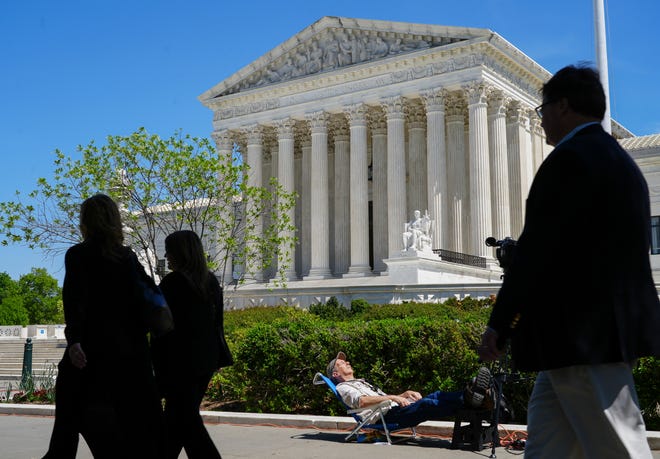
WASHINGTON – The Supreme Court on Friday allowed full access to the abortion pill mifepristone, resolving for now a massive and fast moving conflict over the drug while the underlying lawsuit is decided.
Of immediate significance were restrictions on access to mifepristone that were set to take effect at midnight, including a requirement that Americans sit for in-person visits with doctors and a prohibition on the drug being dispensed through the mail. The Food and Drug Administration lifted those restrictions through a series of actions since first approving the drug in 2000, but a federal appeals court had put them back in place.
The Supreme Court's decision Friday means those restrictions will not be imposed and the drug will remain available as it was before a series of court orders limiting access to it. As is often the case in emergency appeals, the court did not explain its reasoning.
How did the Supreme Court rule in the abortion pill case?
- Friday's ruling: In an unsigned, one-paragraph order, the court sided with the Biden administration and allowed broad access to the drug as the legal fight over the drug continues. Justices Clarence Thomas and Samuel Alito said they would have sided with the anti-abortion groups challenging the drug.
- What happens next? The case now returns to the U.S. Court of Appeals for the 5th Circuit, which is weighing the underlying issues raised by the case.
What's the reaction to the Friday mifepristone ruling?
President Joe Biden quickly applauded the decision.
"As a result of the Supreme Court’s stay, mifepristone remains available and approved for safe and effective use while we continue this fight in the courts," Biden said in a statement Friday evening. "I continue to stand by FDA’s evidence-based approval of mifepristone, and my administration will continue to defend FDA's independent, expert authority to review, approve, and regulate a wide range of prescription drugs."
Jessica Ellsworth, an attorney at Hogan Lovells who represented the drug manufacturer that makes the brand name version of mifepristone, said the decision "preserves crucial access to a drug relied on by millions of patients." The order, she said, "provides continuity to all concerned as we litigate the underlying issues in this case."
Thomas and Alito said they would have denied the Biden administration's request and allowed the restrictions on the drug to take effect.
That action "would not remove mifepristone from the market," Alito wrote in a dissent from the court's decision. "It would simply restore the circumstances that existed (and that the government defended) from 2000 to 2016 under three presidential administrations," Alito wrote.
Thomas did not explain his views.
Alliance Defending Freedom, which filed the lawsuit against the FDA, downplayed the decision.
"As is common practice, the Supreme Court has decided to maintain the status quo that existed prior to our lawsuit while our challenge to the FDA's illegal approval of chemical abortion drugs and its removal of critical safeguards for those drugs moves forward," the group's senior counsel, Erik Baptist, said in a statement. "We look forward to a final outcome in this case that will hold the FDA accountable."
How did the abortion pill case wind up at the Supreme Court?
The legal battle over mifepristone, which has played out in a series of last-minute decisions and middle-of-the-night court filings, landed as the nation is still grappling with the Supreme Court's decision last year to end the constitutional right to abortion that Roe established in 1973. With some states banning abortion in response to that ruling, access to mifepristone has become even more significant for both sides of the debate.
Safety:Mifepristone 'safer than Tylenol,' experts say amid court battle
Courts:Can Biden ignore the courts? Some float defiance on abortion pill ruling.
Explainer:What to know as mifepristone 'abortion pill' battle makes its way to SCOTUS
Medication abortion accounts for about half of all U.S. abortions, and a wide array of government agencies and outside experts have said the drug is safer than common drugs such as Tylenol and Viagra. But the anti-abortion groups challenging the drug questioned those studies and argued that the FDA didn't follow its own protocols and ignored contrary data as it expedited the drug's approval.
The latest legal drama over abortion began earlier this month when a pair of federal court rulings on April 7 plunged the fate of mifepristone into uncertainty. One of those rulings, from U.S. District Judge Matthew Kacsmaryk, effectively invalidated the FDA's 23-year-old approval for the drug. Days later, a federal appeals court in Louisiana sided with the Biden administration on the drug's approval but allowed to stand the parts of Kacsmaryk's ruling that halted efforts to expand access to the drug.

In 2016, for instance, the FDA allowed pregnant people to take the drug three weeks longer into a pregnancy. And the agency allowed pharmacists to prescribe the drug. In 2019, the FDA approved a generic version of the drug. In 2021, during the pandemic, it allowed mifepristone to be dispensed through the mail. The agency formalized that mail-order decision earlier this year.
A three-judge panel of the 5th Circuit ruled the anti-abortion groups challenging the drug waited too long to sue over its approval. But a divided panel said that wasn't the case for subsequent efforts to expand access to the drug and it allowed Kacsmaryk's decision blocking those actions to stand.
As had long been expected, the Biden administration rapidly appealed to the Supreme Court and Justice Samuel Alito, who handles emergency matters from the 5th Circuit, put all the lower court orders on hold to give both sides time to submit their briefs.
Though the Biden administration asked the Supreme Court to consider hearing arguments in the case, the fight over mifepristone now instead returns to lower courts. That means the issue could be back before the Supreme Court within a few months.
Source link







